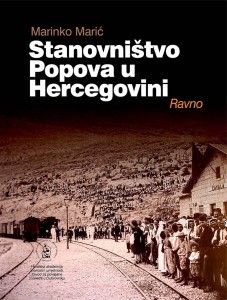 Marinko Marić, Stanovništvo Popova u Hercegovini: Ravno. Zagreb-Dubrovnik: Zavod za povijesne znanosti HAZU u Dubrovniku, 2015.
Marinko Marić, Stanovništvo Popova u Hercegovini: Ravno. Zagreb-Dubrovnik: Zavod za povijesne znanosti HAZU u Dubrovniku, 2015.
Today, as well as in the period of the Dubrovnik Republic, the region of Ravno in Popovo belonged to another state. Despite that, this region was in the narrowest gravitational circle of Dubrovnik, similarly to Dubrovačko primorje or Konavle. In any moment in the past, in Dubrovnik there was 10-15% of population which originated from Popovo in Hercegovina. Therefore, the research of the population of Ravno, published by Marinko Marić, is relevant not only for the local population, but is important in considering the historical demography of entire space of Dubrovnik and Dubrovnik Republic.
In his research, Marinko Marić faced many difficulties. A lot of archival documents in Hercegovina, especially registers, have been destroyed during its restless history. Marić compensated for that lack by investigating numerous ecclesiastic and Ragusan documents in which he found data regarding the population and individual families. The monograph brings the estimates of population in various periods, its religious structure, and vital statistics. It also analyses numerous other demographic factors which relate to the structure of the population, demographic rhythms, and migrations, especially emigration. The author has also reached conclusions which surpass the micro-region he investigated. Especially interesting is his analysis of monthly distribution of weddings considering the varying duration of Lent. He is the first researcher in Croatia who made this calculation, establishing precisely for every year the time of the Lent. Moreover, extremely interesting is also his analysis of the refugees during the Herzegovinian revolt, when three quarters of the inhabitants of the parish Ravno fled to Dubrovnik and Dubrovačko primorje. Great interest of the historiography will also be awakened by the fact that in 1847 the parish priests in Popovo received a decree forbidding the best man to take the bride into the marital bed.
The book is accompanied by the DVD with an excellent documentary “The population of Popovo in Herzegovina: the sign of the times”, which depicts the struggle between man and nature in the unique phenomenon of Popovo polje, which is a deep lake during one part of the year, and a fertile field during another. This touching movie exemplifies Marić’s analysis and after watching it the spectator can’t but feel fortunate for not having been born some fifty or hundred years before.
